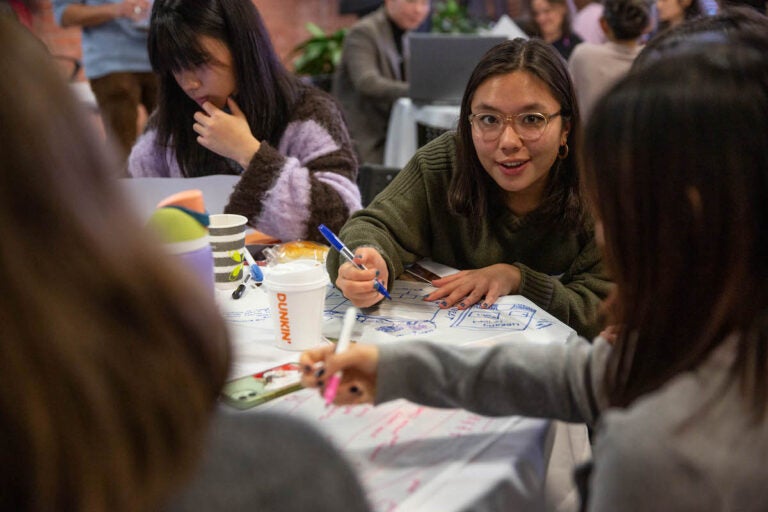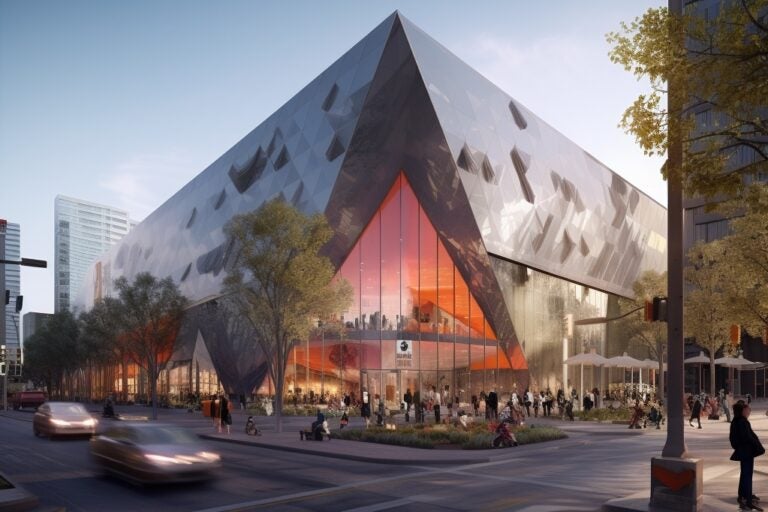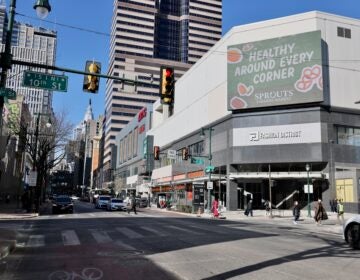Design workshop offers alternative ideas to 76ers proposal to build a new arena in Center City
More than a hundred designers, planners, professors and local residents came together Saturday to explore new visions for the Market Street corridor.

The Save Chinatown Coalition brought over 140 community members (plus a waitlist) on Jan. 27, 2024 to a hall at the Center for Architecture and Design for a community-sourced design workshop to envision alternative uses for the 1000 blocks of Market and Filbert streets in Center City, where the 76ers are proposing to build a basketball arena. The workshop had 12 tables with different mediums in the center for the attendees to explore different ways the city could utilize the space. (Emily Cohen for WHYY)
From Philly and the Pa. suburbs to South Jersey and Delaware, what would you like WHYY News to cover? Let us know!
Should a new basketball arena be built in Center City for the 76ers?
The answer is a resounding “no” according to a coalition of community groups and grassroots organizations that are developing different ideas they want Philadelphia lawmakers to consider.
During a brainstorming workshop held Saturday morning, more than a hundred designers, planners, graduate students, professors and local residents came together to explore new visions for the Market Street corridor.
Rashida Ng is an architecture professor at the University of Pennsylvania.
“We’re trying to provide a platform and an opportunity for Philadelphians from across the city to really envision alternatives to the Sixers proposal,” she said.

She said the organization wants to build a big new basketball arena, “but there hasn’t been a real public process to envision alternatives, there isn’t a plan for this area that says, oh yes, a stadium would have this kind of impact and this kind of benefit.”
Mary Yee, the chair of the technical planning committee for the Save Chinatown Coalition, said many people don’t believe constructing a new arena is the best idea for development in the downtown area.
“Right now it’s basically all retail, and so is there a mix of uses that would be more optimal, and also serve better the communities in and around Center City,” she said.

Yee said based on an online survey of thousands of Philadelphians conducted at the end of December into the first part of January, other development options for the area could include more housing, small business opportunities and having open space areas.
Based on the survey results, researchers at the University of Pennsylvania Weitzman School of Design used artificial intelligence to create several pictures of how the neighborhood could be “reimagined.”
Concepts that were “brought to life” in realistic renditions include a night market, an adaptive reuse library, a new cultural center and an elevated green space park.

Other displays at the design workshop used interactive block models to explore program possibilities for the proposed site, and included drawings of alternative site concepts.
Ng said they are looking to generate ideas that will allow “Chinatown to continue to thrive as an immigrant community.”
“It’s a really important entry portal for people coming to the Philadelphia area from other countries in Asia and elsewhere,” she said.

Yee said building a new arena right next to Chinatown would have a negative impact on the community economically, and from a health and transportation perspective.
“Chinatowns in history have been looked at as disposable, have been looked at as blighted areas,” she said, “I think this is an example of basically institutional racism.”
Over the decades, Chinatown has been assaulted by numerous large infrastructure projects, Yee said, noting that city leaders would say in response that they “never knew Chinatown was a neighborhood.”
Domenic Vitiello is a professor of city planning and urban studies at the University of Pennsylvania.
He said it’s important for the city to have “a healthy civic conversation about what Philadelphians would really like to see on East Market Street, and what could make it a much healthier place for all of us.”
He said he’s studied Chinatowns across the United States and Canada, and Philadelphia’s Chinatown “has a history of being largely destroyed, close to 40% of Chinatown was destroyed by urban renewal projects, including the parking lots that were built to service the Gallery Mall.”
Yee agreed, noting “a lot of times we’re looked at as being invisible.”

An estimated 3,000 to 5,000 residents currently live in Chinatown.
She said different development concepts that do not include demolishing a major part of the neighborhood to make way for a new arena will be presented to city leaders in the coming weeks.
“The city has not done due diligence in investigating what made Market Street East or the Fashion District fail, and planning for what might be a more optimal mix of uses, a better urban design, the city has had a lack of imagination and we need to basically step in here,” Yee said.

Get daily updates from WHYY News!
WHYY is your source for fact-based, in-depth journalism and information. As a nonprofit organization, we rely on financial support from readers like you. Please give today.
















